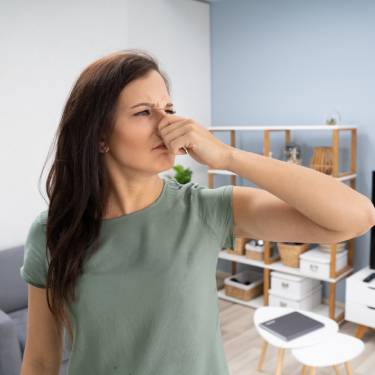
We’ve all been there—a mysterious odor makes its way through your home, and no amount of air freshener can mask it. Strange smells in a house can leave any homeowner scratching their head. The source of unpleasant odors is often hiding in plain sight, and tracking it down could save your nose (and your sanity). To help you do just that, let’s explore the usual suspects of strange smells in your home and where they might be lurking.
Kitchen
The kitchen is undoubtedly the heart of most homes, but it can also be a breeding ground for many odors. Start by checking your garbage disposal. Food waste that sticks around inside might create a funky smell. Running lemon wedges through the disposal can freshen things up quickly. Another likely culprit is the refrigerator. Forgotten leftovers or expired condiments can emit powerful odors. Go shelf by shelf, toss out the offenders, and wipe clean any spills. Don’t forget to inspect your oven or stove drip pans. Burnt food remnants might be the culprits for creating that smoky or sour smell.
Bathroom
Ah, the bathroom. A space designed for hygiene can quickly become the source of offending odors without you realizing it. Check your drains first—soap scum and hair buildup in the sink or shower pipes could be creating a musty or sulfurous smell. Sometimes, the issue lies within hidden mold or mildew, which often forms in damp areas like under the sink or in shower grout. Keep an eye on ventilation; a poorly ventilated bathroom invites odors to linger longer than anyone would like.
Laundry Room
Like with bathrooms, you would assume a space dedicated to cleaning wouldn’t smell—but you’d be wrong. Washing machines, especially front loaders, are often the culprits when it comes to laundry rooms. The rubber gasket can harbor moisture, trapping detergent residue, lint, or even mildew—and causing a musty smell each time you open the door. If you use a dryer, lint traps and vents blocked with lint or dust may create a burnt odor. Inspect and clean them regularly not only to eliminate smells but to keep things running safely.
Crawl Space
Crawl spaces often go unnoticed—until they start to smell. These dark and often humid areas are prime real estate for mold growth, but there are a variety of reasons why your crawl space might smell. Regardless of the reason, many odors in crawl spaces may smell earthy or even downright putrid. Water leaks or moisture buildup can intensify the smell over time, so a thorough inspection is vital. Ensure proper ventilation and invest in a dehumidifier if necessary to avoid long-lasting issues beneath your home.
Bedroom
Your personal sanctuary should smell fresh, but sometimes, it can be the source of bad smells in your home. Dust mites in bedding or upholstery can contribute to a stale odor, especially if sheets aren’t washed regularly. If you notice a damp smell, there could be unnoticed spills or even hidden mold caused by humidity. Carpets are another sneaky odor source—they often hold onto pet dander, food smells, or everyday dirt. A deep clean or baking soda treatment can help neutralize lingering smells and refresh your sleep space.
Bio: Casey is a passionate copyeditor highly motivated to provide compelling SEO content in the digital marketing space. Her expertise includes a vast range of industries from highly technical, consumer, and lifestyle-based, with an emphasis on attention to detail and readability.




















